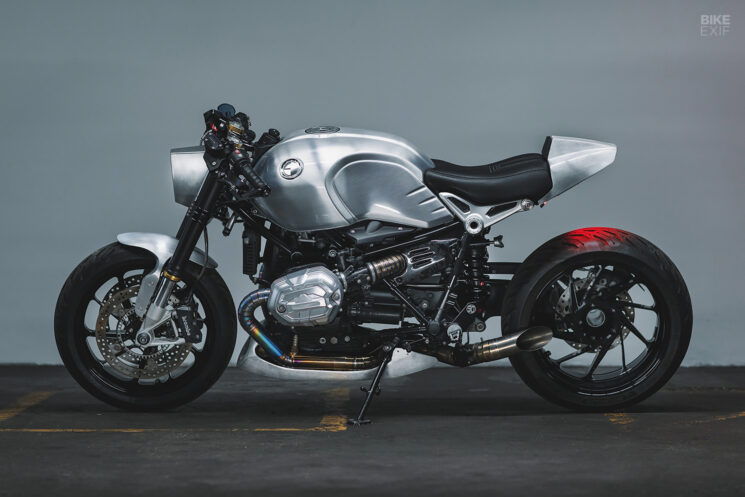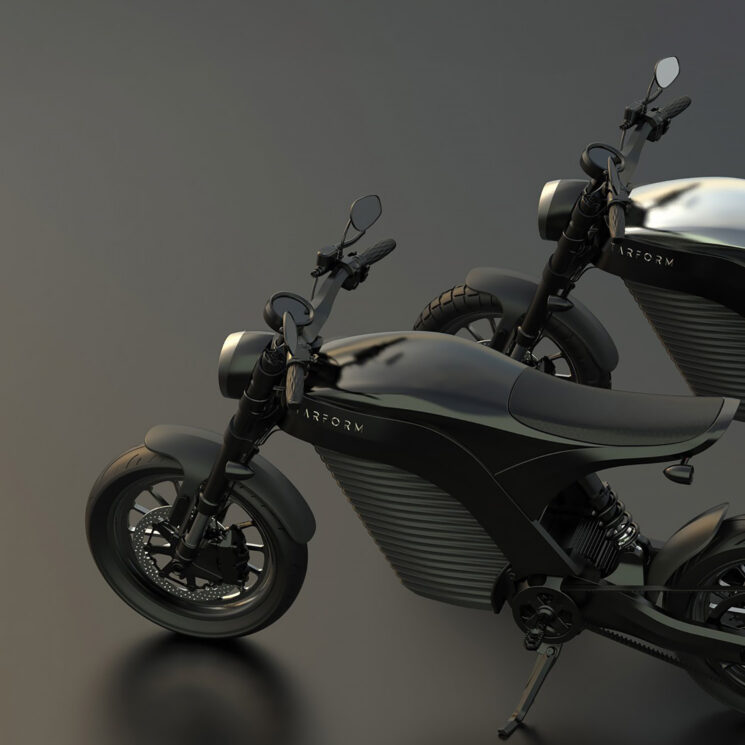
Two very different BMW boxers set things off this week; a BMW R nineT café racer from New York, and a BMW R1200R inspired by the Yamaha Banshee ATV. We also look at a crazy Yamaha SR400 from Japan and the new Tarform Vera electric motorcycle.

BMW R nineT by Douglas Sondors Have you ever found yourself living in New York City and needing to improve your daily commute? That’s how Douglas Sonders became the proud owner of a 2016 BMW R nineT Roadster. He soon had some design concepts that he wanted to explore though—so he spent late nights and weekends doing so with help from his friends.
The most notable change to the overall look of Douglas’ R nineT is the one-off headlight and tail unit. Sitting down and sketching it out with his fabricator and best mate Tim Harney, the pair came up with their own retro-retro design.

Once they were happy, Tim knocked up the headlight and tail unit from sheets of alloy to create a very unique aesthetic. The vertical LED headlight is surrounded by a narrow alloy fairing that, although shaped differently, still blends nicely into the tank. The tail tells a similar story, but there are more classical elements at play.
Perfectly proportioned, it brings to mind aerodynamic elements of old D-Type Jaguars, but executed in a delightfully modern way. The custom seat design is from McCoy’s Upholstery in NYC, and the custom LED taillight assembly is Tim’s handiwork. A new rear shock from Wilbers props up the rear.

Up front, clip-on handlebars flank a new Motogadget Motoscope Pro dashboard, perfectly mounted to black CNC yokes from JC R9T in Taiwan (who also supplied the handlebars). The mirrors are from Puig and there are discrete Rizoma turn signals hidden away somewhere on the bike. BMW Option 719 Classic rocker covers were installed to match the alloy tank.

JC R9T also supplied the matching alloy belly pan, the forged aluminum wheels, and that slinky titanium exhaust—the design of which is echoed in the pie-cut intake manifolds. The tank is dressed with CNC badges and a blocky air intake cover from Pier City Customs. The ECU was flashed by BT Moto for improvements to the fueling.
It’s a subtle—yet effective—build by Mr Sondors, and we honestly can’t think of a better way to get around NYC’s bustling streets. [Douglas Sonders Instagram]

BMW R1200R by Rind Performance When Yamaha released the fire-breathing Banshee ATV back in 1987, not even they expected the success and praise it garnered. To this day, crazy people are tuning the 350 cc two-stroke twin engine to within an inch of its life. It’s just one of the reasons why the Banshee is firmly cemented into history as one of the best quads of all time.
Robin of Rind Performance is a big fan of the Banshee. So, having built several outstanding hooligan BMW boxers already, he thought he would draw on the Banshee for inspiration for his latest project. With a 2015 BMW R1200R as the donor, this is his one-of-a-kind tribute.

Robin promptly discarded most of the BMW’s bodywork and the entire subframe. The fuel tank was redesigned but still uses the factory fuel pump and level sensor to keep the BMW computer system happy. The OEM dashboard is still fitted to the bike too, but it’s been relocated to sit on top of the tank.
The headlight nacelle and beak were designed in CAD and 3D printed. Together with the tank panels, this is where the Banshee inspiration is most obvious, especially with the stunning red paint. Small LED projector lights are hidden above the front fender.

At the heart of the bike is BMW’s liquid-cooled 1,170 cc boxer engine, but what it lacks in two-stroke smoke, it makes up for in power. At 125 hp and 125 Nm of torque, there’s more than enough get-up-and-go for the street.
The rear fender is modeled on an old MX bike and sits just behind a custom seat. There’s not a lot of real estate out back, so the taillight and turn signals were relocated to a swingarm-mounted license plate bracket.

The number plate side panels are a great touch, as are the bright red grips on the new flat-track handlebars. A set of spoked wheels was sourced too, along with an electronic quick-shifter and a Unit Garage exhaust system.
The finished result is not only functional, it’s incredible to look at. It’s undoubtedly lost more than a few pounds of weight over the stock bike too, so we’ll take a punt and guess that it rides as good as it looks. [Source]

Yamaha SR400 by Candy Motorcycle Laboratory It was a gloomy moment when Yamaha stopped producing the venerable SR400 in 2021. Thanks to tooling that probably paid for itself decades ago, the old single-cylinder standard was cheap to buy and run. And since it complied with Japan’s 400 cc licensing requirements, it was popular among youths too.
With younger members of society always striving for individualism, it wasn’t long until entire companies were set up to supply a steady stream of aftermarket SR parts. That’s how Candy Motorcycle Laboratory—a two-man band just 40 minutes from central Yokohama—got started.

Candy MC Lab was recently approached by a client looking to transform his Yamaha SR400 into a sleek, modern café racer with a focus on performance. They started by swapping out the factory suspension for something more modern. The twin-shock rear end was replaced with a mono-shock, single-sided swingarm from a Ducati Hypermotard, with the Hypermotard also donating its rear brakes.
The mono-shock conversion meant the team had to drastically change the rear subframe, so they made an entirely new one from tubular steel. The looped rear end has an integrated tail light and a well-padded custom suede seat—perfect for solo rides through the busy streets of Japan, especially with the new Öhlins rear shock.

Up the other end, a set of Showa USD forks and a new top clamp were bolted to the front. The spoked Borrani wheels are another custom touch, with the rear wheel being laced to a custom hub because of the new swingarm.
The tank is a BMW R100 unit that’s been modified to fit the Yamaha frame. It was also narrowed to match the proportions of the bike and had a Monza-style fuel cap fitted. A Motogadget speedo is embedded into the top clamp, and there are Motogadget turn signals front and rear.

An LED headlight brightens things up, mounted on a custom center-mount bracket. Low clip-on handlebars and big Brembo brakes lean into the performance aspect of the build.
Besides a fresh coat of wrinkle-black paint, the engine was treated to a new top end, ST-1 cams, and a performance piston, bringing the capacity to 534 cc. A 41mm FCR carburetor with an open velocity stack takes care of the fueling, while hot air exits through a low-slung custom stainless steel exhaust that you’re likely to hear coming from a mile away. [Source]

Tarform Vera Brooklyn-based Tarform arrived on the motorcycle scene in 2020 with the Luna—an elegant electric motorcycle sporting swathes of non-toxic, high-performance biomaterials. The Luna was Tarform’s idea of electric mobility done right, but with a waitlist of four to six months, and with prices starting at $28,000, it isn’t exactly accessible.
Tarform’s new bike, the Vera, is smaller, lighter, and less expensive. (Although at $16,000, it’s certainly not cheap.)

Compared to the Luna, the Vera’s wheelbase comes in at 56”, the seat height is an inch lower, and it weighs 80 lbs less. The smaller, lighter bike seems to have a speed advantage over its bigger brother too; the Vera beats the Luna to 60 mph by 0.2 seconds, while boasting the same torque and top speed specs (163 Nm and 85+ mph, respectively).
Stylistically, you can still tell it’s a Tarform motorcycle. While the Luna had a visible split between the ‘tank’ and seat, the Vera sports a flatter transition from the seat to the ‘tank’ area, not unlike a dirt bike. Tarform is pitching the Vera as a lighter, more scrambler-esque version of the Luna, so this makes sense.

The horizontal strakes on Vera’s 8 kW battery pack are a very nice detail, helping to disguise its visual bulk. The air-cooled, direct-drive electric engine sits low in the frame, the brakes are from Brembo, and the 3.4-inch Retina display comes with 4G connectivity for over-the-air updates. (We think that’s a feature all new motorcycles should have.)
The range sits at 100 city miles and you charge the battery from empty to full in four hours using a standard 110 V household outlet, or two hours using a 220 V or J1772 plug. 100 miles might not sound like much, but if you live and work in a city that’s more than enough—especially if you can plug the bike in when you get to work. [Tarform]
